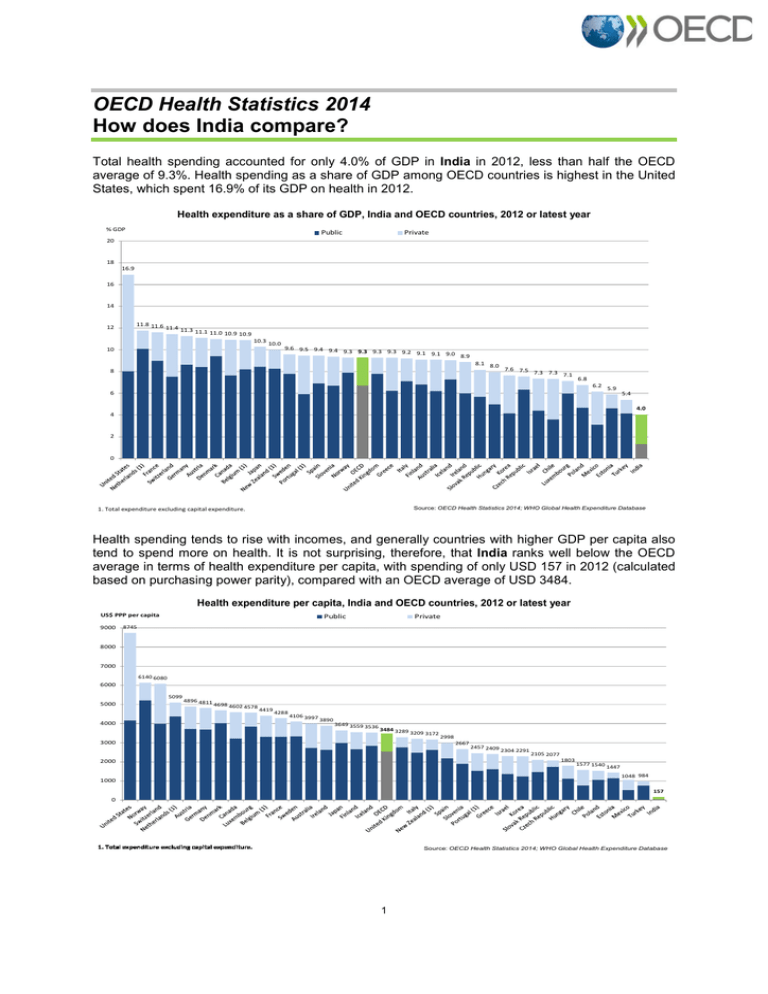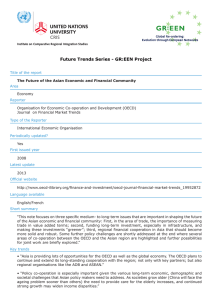OECD Health Statistics 2014 How does India compare?
advertisement

OECD Health Statistics 2014 How does India compare? Total health spending accounted for only 4.0% of GDP in India in 2012, less than half the OECD average of 9.3%. Health spending as a share of GDP among OECD countries is highest in the United States, which spent 16.9% of its GDP on health in 2012. Health expenditure as a share of GDP, India and OECD countries, 2012 or latest year % GDP Public Private 20 18 16.9 16 14 12 11.8 11.6 11.4 11.3 11.1 11.0 10.9 10.9 10.3 10.0 10 9.6 9.5 9.4 9.4 9.3 9.3 9.3 9.3 9.2 9.1 9.1 9.0 8.9 8.1 8.0 8 7.6 7.5 7.3 7.3 7.1 6.8 6.2 6 5.9 5.4 4.0 4 2 0 Source: OECD Health Statistics 2014; WHO Global Health Expenditure Database 1. Total expenditure excluding capital expenditure. Health spending tends to rise with incomes, and generally countries with higher GDP per capita also tend to spend more on health. It is not surprising, therefore, that India ranks well below the OECD average in terms of health expenditure per capita, with spending of only USD 157 in 2012 (calculated based on purchasing power parity), compared with an OECD average of USD 3484. Health expenditure per capita, India and OECD countries, 2012 or latest year US$ PPP per capita 9000 Public Private 8745 8000 7000 6140 6080 6000 5099 5000 4000 4896 4811 4698 4602 4578 4419 4288 4106 3997 3890 3649 3559 3536 3484 3289 3000 3209 3172 2998 2667 2457 2409 2304 2291 2105 2077 1803 2000 1577 1540 1447 1048 984 1000 157 0 Source: OECD Health Statistics 2014; WHO Global Health Expenditure Database 1 The public sector is the main source of health funding in nearly all OECD countries. However, in India, only 33% of health spending was funded by public sources in 2012, a much lower share than the average of 72% in OECD countries. Health accounted for only 4.8% of total government spending in 2012, significantly lower than the 14.4% across OECD countries. Out-of pocket costs accounted for 60% of health spending in India in 2012, higher than in any other OECD country. Health care resources and activities In 2012, India had only 0.7 physicians per 1000 population, well below the OECD average of 3.2. And even then, the number of doctors in India is probably over-estimated, as it is based on medical registers which are not updated regularly to account for migration, retirement or death, nor do they take into account doctors registered in multiple states. There was 1.1 nurse per 1000 population in India in 2012, also much lower than the average of 8.8 in OECD countries. About 75% of children in India were vaccinated against diphtheria, tetanus and pertussis (DTP) and measles in 2012, less than the coverage in most OECD countries which is close to 100%. Health status and risk factors Most countries have enjoyed large gains in life expectancy over the past decades, thanks to improvements in living conditions, public health interventions and progress in medical care. Life expectancy at birth in India has increased by almost 25 years since 1960 to reach 66.3 years in 2012. Nonetheless, it still remains 14 years lower than the OECD average (80.2 years). The infant mortality rate in India has been cut in half over the past two decades, coming down from 88.2 deaths per 1000 live births in 1990 to 43.8 deaths in 2012. Nonetheless, it remains more than ten times higher than the OECD average (4.0 deaths per 1000 births). The percentage of low birth weight infants in India is also much higher than in OECD countries: 27.6% of newborns in India in 2011 were defined as having a low birth weight (weighing less than 2 500 grams) compared with 6.8% on average in OECD countries. While genetic factors play a role, the proportion of low birth weight infants is generally higher in lower-income families in India as is the case also in other countries. Tobacco smoking is a major risk factor for a number of causes of death, including cardiovascular diseases and a range of cancers. Only 10.7% adults smoked daily in India in 2010, two times less than the OECD average (21.0%). However, there remains an important gender gap in smoking rates in India, with many more Indian men (18.3%) than women (2.4%) smoking daily. More information on OECD Health Statistics 2014 is available at www.oecd.org/health/healthdata. For more information on OECD's work on India, please visit www.oecd.org/india. 2






